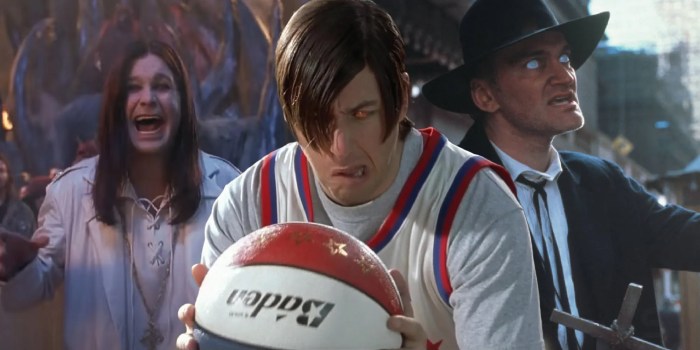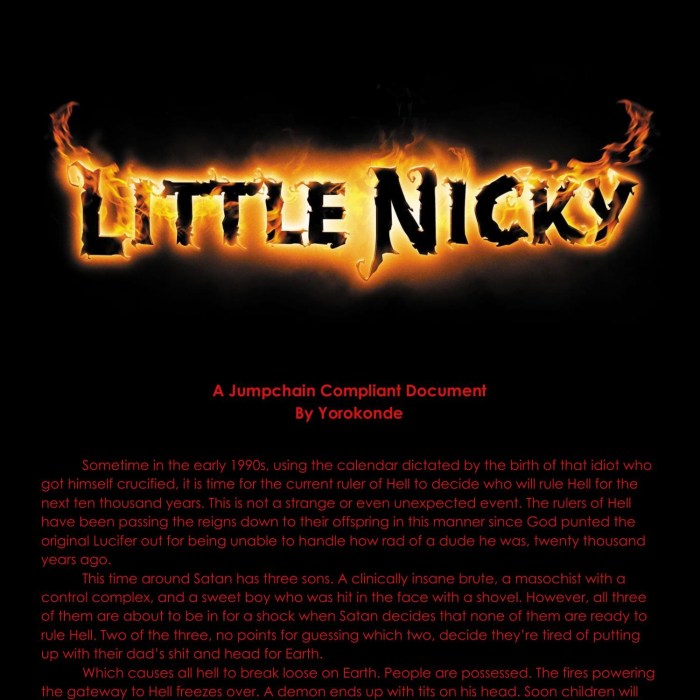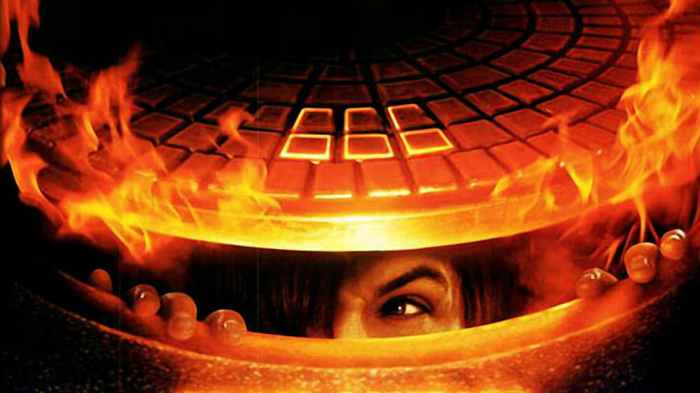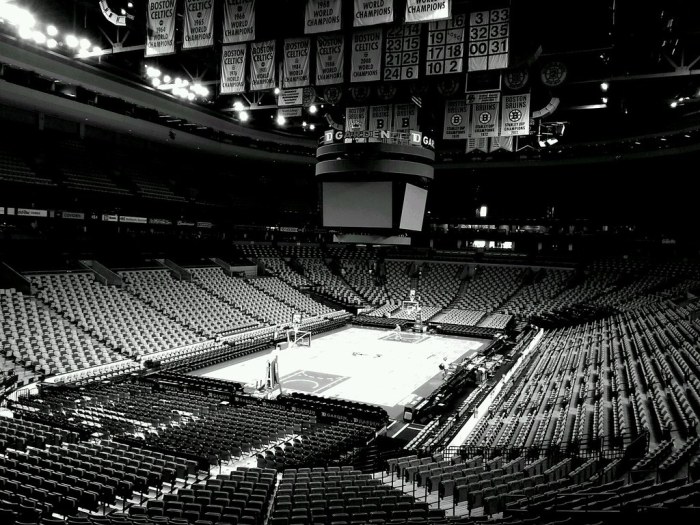Prepare yourself for an extraordinary cinematic adventure as we delve into the captivating world of “Little Nicky,” a film that has left an indelible mark on popular culture. With its unique blend of humor, satire, and supernatural elements, this motion picture has garnered a loyal following and continues to entertain audiences to this day.
Join us as we explore the intricate tapestry of characters, themes, and cinematic techniques that make “Little Nicky” a truly unforgettable experience.
Released in 2000, “Little Nicky” follows the hilarious misadventures of Nicky, the son of the Devil himself. Despite his infernal lineage, Nicky possesses a heart of gold and a burning desire to escape the clutches of his wicked family. As he embarks on a perilous quest to save his beloved father, Nicky encounters a colorful cast of characters, including the archangel Michael, the seductive temptress Valerie, and the lovable yet dimwitted Beef.
Along the way, he must confront his own inner demons and learn the true meaning of good and evil.
Plot Summary
Little Nicky is a 2000 American supernatural comedy film directed by Steven Brill and starring Adam Sandler, Harvey Keitel, Patricia Arquette, Reese Witherspoon, and Rodney Dangerfield. The film follows the story of Nicky, the son of Satan, who must travel to Earth to prevent his father from taking over the world.
Nicky is a kind-hearted and naive demon who has always been overshadowed by his older brothers, Cassius and Adrian. When his father, Satan, announces that he is retiring and plans to give the throne of Hell to the most evil of his sons, Nicky sets out on a journey to Earth to prove that he is not as evil as his brothers.
Nicky’s Journey
On Earth, Nicky meets a variety of characters, including a prostitute named Valerie Veran, a homeless man named John, and a priest named Father McFee. With their help, Nicky learns about the power of love and compassion. He also discovers that his true calling is not to be evil, but to be a force for good.
Confrontation with Cassius and Adrian
Nicky’s journey culminates in a confrontation with his brothers, Cassius and Adrian. Cassius and Adrian are determined to stop Nicky from taking over Hell, and they use all their powers to defeat him. However, Nicky is able to overcome his brothers with the help of his newfound friends.
In the end, Nicky defeats his brothers and becomes the new ruler of Hell.
Character Analysis
Little Nicky is the protagonist of the movie, and his character arc revolves around his journey from a naive and sheltered life to becoming a responsible and compassionate ruler of Hell. Nicky is initially portrayed as a kind-hearted and gentle soul who is ill-suited for the role of the Devil.
However, as the story progresses, he demonstrates unexpected courage and determination, proving that he is more than just his father’s son.
Nicky’s relationship with his father, Satan, is a complex one. Satan is a cruel and manipulative figure who constantly belittles and torments his son. Despite this, Nicky retains a deep-seated love for his father and desperately seeks his approval. This dynamic adds a layer of emotional depth to the story and provides a poignant exploration of the father-son bond.
Supporting Characters
The supporting cast of characters in Little Nicky is equally memorable and adds to the film’s unique blend of humor and heart. Nicky’s half-brother, Adrian, is a charismatic and charming demon who serves as Nicky’s mentor and guide. Adrian’s unwavering loyalty and support provide Nicky with the strength and confidence he needs to face the challenges that lie ahead.
Another notable character is Valhallen, a Viking berserker who becomes Nicky’s unlikely ally. Valhallen’s brute strength and unwavering loyalty make him a formidable force on Nicky’s side. His interactions with Nicky provide some of the film’s most humorous moments, as the two characters come from vastly different worlds but find common ground in their shared desire to protect those they care about.
Themes and Symbolism

The movie Little Nicky delves into profound themes that resonate with the human experience. At its core, it explores the eternal battle between good and evil, the transformative power of redemption, and the enduring strength of love. These themes are interwoven throughout the narrative and conveyed through evocative symbolism and imagery.
Good vs. Evil
The conflict between good and evil is a central thread running through the movie. Nicky, the titular character, represents the forces of good, while his father, Satan, embodies the powers of darkness. The battle between them symbolizes the eternal struggle between light and shadow, right and wrong, and the choices individuals make in the face of adversity.
Redemption
Redemption is another key theme explored in Little Nicky. Nicky, despite being the son of the devil, embarks on a journey of self-discovery and redemption. His transformation from a spoiled and irresponsible demon to a compassionate and heroic figure serves as a reminder that even the most flawed individuals can find redemption through acts of love and sacrifice.
The Power of Love
The movie also emphasizes the transformative power of love. Nicky’s love for his father, despite his shortcomings, drives his quest for redemption. It is through the power of love that Nicky is able to overcome his inner demons and embrace his true potential.
The movie suggests that love has the ability to conquer even the darkest of forces and bring about positive change in the world.
Humor and Satire
Little Nicky employs a potent blend of humor and satire to critique religious and societal norms, offering a sharp and irreverent commentary on the human condition.
The film’s humor is often derived from its outrageous and absurd premise. Nicky, the son of Satan, is sent to Earth to prevent his father from unleashing Hell on the world. This premise allows for a wide range of comedic scenarios, from Nicky’s encounters with mortals to his interactions with his demonic siblings.
Satirical Elements
Beneath the surface of its comedy, Little Nicky also carries a satirical edge. The film skewers religious institutions, questioning their dogmas and practices. For instance, the character of God is portrayed as a petty and vengeful figure, while Satan is presented as a more compassionate and relatable character.
The film also satirizes societal norms, particularly the concept of good and evil. Nicky’s quest to prevent Hell from invading Earth is complicated by the fact that many humans are themselves capable of great evil. This suggests that the boundaries between good and evil are not always clear-cut, and that humans are not always as virtuous as they believe themselves to be.
Visual Style and Cinematography
Little Nicky stands out visually with its distinctive camerawork, lighting, and color palette. The film employs unconventional camera angles, often placing the camera at extreme heights or low perspectives, creating a sense of disorientation and chaos that reflects the protagonist’s inner turmoil.
The lighting is often dark and moody, with shadows and silhouettes emphasizing the film’s supernatural elements. The color palette is dominated by shades of red and green, creating a visually jarring and unsettling atmosphere that complements the film’s dark humor.
Camera Angles
- Extreme high angles make characters appear small and insignificant, highlighting their vulnerability and the overwhelming nature of their challenges.
- Low angles create a sense of intimidation and power, particularly when used to capture the demonic characters.
- Canted angles and shaky camerawork convey a sense of instability and chaos, mirroring the protagonist’s internal struggles.
Music and Sound Design

Music and sound design play a crucial role in enhancing the storytelling of Little Nicky. The soundtrack, composed by Brian Tyler, perfectly captures the film’s dark and comedic tone. The use of heavy metal and industrial sounds creates an atmosphere of chaos and absurdity, while the occasional use of orchestral pieces adds a touch of grandeur and emotion.
Sound Effects
The sound effects in Little Nicky are equally impressive. The exaggerated sound of Nicky’s flatulence and the cartoonish squeaks and honks of the Devil’s minions add to the film’s slapstick humor. The use of sound effects also helps to create a sense of danger and suspense during the film’s action sequences.
Soundtrack
The soundtrack of Little Nicky is a blend of heavy metal, industrial, and orchestral music. The use of heavy metal and industrial sounds creates an atmosphere of chaos and absurdity, while the occasional use of orchestral pieces adds a touch of grandeur and emotion.
The soundtrack perfectly captures the film’s dark and comedic tone.
Cultural Impact and Legacy
Little Nicky left an indelible mark on popular culture, becoming a cult classic beloved by fans worldwide. Its unique blend of raunchy humor, over-the-top characters, and memorable dialogue has ensured its enduring appeal.
The film’s influence can be seen in countless subsequent comedies, with its crude humor and outlandish characters inspiring a new generation of filmmakers. The character of Nicky, with his naivete and unwavering belief in the power of love, has become an iconic figure, often referenced in popular culture.
Cult Status
Little Nicky’s cult status stems from several factors. Its unconventional and offbeat nature set it apart from mainstream comedies, appealing to audiences seeking something different. The film’s raunchy humor and willingness to push boundaries resonated with fans, who found it both outrageous and hilarious.
Additionally, Little Nicky’s quotable dialogue and memorable characters have made it a favorite among fans. Lines like “You can’t kill the devil, Nicky. He’s too mean to die!” have become part of the film’s enduring legacy, ensuring its continued popularity.
Critical Reception and Reviews

Little Nicky received mixed reviews from critics and audiences. Some praised its originality and dark humor, while others criticized its excessive use of crude jokes and toilet humor.
Strengths
Critics and fans alike agreed that Adam Sandler’s performance as the titular character was a highlight. His ability to create a sympathetic and lovable character despite the film’s over-the-top nature was widely praised. Additionally, the film’s visuals were commended for their unique and imaginative style, particularly the depiction of Hell and its inhabitants.
Weaknesses
Despite its strengths, Little Nicky was also criticized for its reliance on lowbrow humor and vulgarity. Many reviewers felt that the film’s jokes often missed the mark, resorting to cheap gags and offensive stereotypes. Furthermore, the film’s plot was considered weak and unoriginal, with a predictable storyline that failed to fully engage viewers.Overall,
Little Nicky is a film that has its moments of brilliance but ultimately falls short of its full potential due to its excessive reliance on crude humor and a weak plot.
Comparisons to Other Works
Little Nicky shares similarities with other comedy and supernatural films, but it also stands out with its unique blend of humor and the supernatural.
One notable comparison is to the 1994 film Clerks , which also features a group of young men working dead-end jobs and dealing with everyday life’s challenges. Both films use crude humor and vulgar language to comedic effect, but Little Nicky adds a supernatural element with the character of Nicky and his demonic family.
The Exorcist
Little Nicky also draws inspiration from classic horror films such as The Exorcist . The film’s portrayal of demonic possession and exorcism is both humorous and terrifying, and it pays homage to the iconic horror film while adding its own unique spin.
Additional Insights and Analysis
Little Nicky is a film that is often overlooked or dismissed as a mere Adam Sandler comedy. However, upon closer examination, it reveals itself to be a surprisingly complex and insightful film with a lot to say about the nature of good and evil, the power of redemption, and the importance of family.
One of the most striking things about Little Nicky is its unique and imaginative world-building. The film creates a fully realized version of Hell, complete with its own set of rules and customs. This world is both visually stunning and surprisingly coherent, and it helps to ground the film’s story in a believable and engaging setting.
The Nature of Good and Evil
One of the central themes of Little Nicky is the nature of good and evil. The film explores the idea that good and evil are not always clear-cut, and that even the most evil people can have a spark of redemption within them.
This theme is explored through the character of Nicky, who is the son of the Devil but who ultimately chooses to do good.
Last Recap
In conclusion, “Little Nicky” stands as a testament to the enduring power of laughter and the timeless appeal of good versus evil narratives. With its unforgettable characters, clever satire, and visually stunning cinematography, this film has rightfully earned its place as a cult classic.
Whether you’re a seasoned fan or a first-time viewer, “Little Nicky” promises an uproarious and thought-provoking cinematic experience that will leave you entertained, challenged, and ultimately uplifted.
Answers to Common Questions
Who is the main protagonist of “Little Nicky”?
Nicky, the son of the Devil
What is the central conflict in the film?
Nicky’s quest to save his father from eternal damnation
What is the significance of the character Beef?
He represents Nicky’s inner struggle between good and evil
How does the film use humor and satire to critique societal norms?
Through over-the-top characters and absurd situations
What is the main theme explored in “Little Nicky”?
The power of redemption and the importance of choosing good over evil

